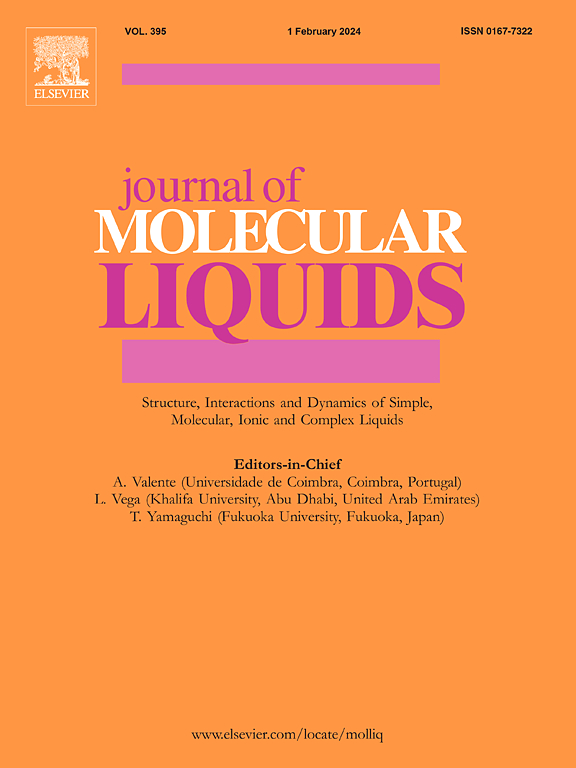The role of hydrogen bond formation in the extracting efficiency of NADES formulations
IF 5.3
2区 化学
Q2 CHEMISTRY, PHYSICAL
引用次数: 0
Abstract
The simplicity and versatility of natural deep eutectic solvents (NADES), together with a wide range of potential applications, make them great candidates to fight the lack of sustainability and circularity in large-scale industrial chemistry. Among the most prominent applications of NADES, extraction of phenolic compounds (PC) from natural sources remains one of the most attractive ones, due to the high commercial value of both, solvent and solute. In the present study, an in-depth analysis of the underlying mechanisms of extraction in NADES-PC systems is performed via quantification of the spin-spin interactions using 2D NMR experiments. The structure of the hydrogen bond donor, acceptor-to-donor molecular ratio, or number and distribution of the hydroxyl groups are determined as key components governing the solubility of PC in NADES. Moreover, our results reveal how studying the solvent hydrogen bond network formation between the NADES acceptor and donors can be easily translatable into understanding the solvation patterns and predicting the solubility efficiency of PC at low concentrations, below the level of direct detection.
氢键形成对NADES配方萃取效率的影响
天然深共晶溶剂(NADES)的简单性和多功能性,以及广泛的潜在应用,使它们成为对抗大规模工业化学中缺乏可持续性和循环性的伟大候选者。在NADES最突出的应用中,从天然资源中提取酚类化合物(PC)仍然是最具吸引力的应用之一,因为溶剂和溶质都具有很高的商业价值。在本研究中,通过使用二维核磁共振实验量化自旋-自旋相互作用,深入分析了NADES-PC系统中萃取的潜在机制。氢键给体的结构、受体与给体的分子比例或羟基的数量和分布是决定PC在NADES中溶解度的关键因素。此外,我们的研究结果揭示了如何研究NADES受体和供体之间的溶剂氢键网络形成可以很容易地转化为理解溶剂化模式和预测PC在低浓度下的溶解效率,低于直接检测水平。
本文章由计算机程序翻译,如有差异,请以英文原文为准。
求助全文
约1分钟内获得全文
求助全文
来源期刊

Journal of Molecular Liquids
化学-物理:原子、分子和化学物理
CiteScore
10.30
自引率
16.70%
发文量
2597
审稿时长
78 days
期刊介绍:
The journal includes papers in the following areas:
– Simple organic liquids and mixtures
– Ionic liquids
– Surfactant solutions (including micelles and vesicles) and liquid interfaces
– Colloidal solutions and nanoparticles
– Thermotropic and lyotropic liquid crystals
– Ferrofluids
– Water, aqueous solutions and other hydrogen-bonded liquids
– Lubricants, polymer solutions and melts
– Molten metals and salts
– Phase transitions and critical phenomena in liquids and confined fluids
– Self assembly in complex liquids.– Biomolecules in solution
The emphasis is on the molecular (or microscopic) understanding of particular liquids or liquid systems, especially concerning structure, dynamics and intermolecular forces. The experimental techniques used may include:
– Conventional spectroscopy (mid-IR and far-IR, Raman, NMR, etc.)
– Non-linear optics and time resolved spectroscopy (psec, fsec, asec, ISRS, etc.)
– Light scattering (Rayleigh, Brillouin, PCS, etc.)
– Dielectric relaxation
– X-ray and neutron scattering and diffraction.
Experimental studies, computer simulations (MD or MC) and analytical theory will be considered for publication; papers just reporting experimental results that do not contribute to the understanding of the fundamentals of molecular and ionic liquids will not be accepted. Only papers of a non-routine nature and advancing the field will be considered for publication.
 求助内容:
求助内容: 应助结果提醒方式:
应助结果提醒方式:


